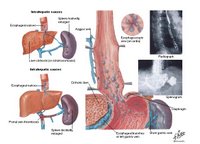
The portal vein is the blood vessel inside the liver which carries blood coming from the intestines and spleen to the liver (splanchnic circulation). When the portal vein becomes obstructed due to certain liver conditions such as cirrhosis, the pressure inside the blood vessel increases. This problem leads to development of collateral circulation diverting the obstructed blood flow to the systemic veins. The esophageal veins which drain into the azygos vein are common collaterals in which blood are diverted into. Hence, esophageal varices develop. These are usually found in the lower esophageal walls and sometimes in the upper part of the stomach. These varices often cause no symptoms unless they rupture and bleed making the condition life-threatening. Their rupture leads to vomiting of blood and passing out of black, tarry stools. When untreated this will lead to symptoms of thirst, decreased urine output and paleness. On physical examination, there is rapid heart rate and low blood pressure. There may also be signs of liver disease. Aside from liver cirrhosis which is the most common cause of portal hypertension, other causes include formation of blood clot in the potal vein (thrombosis), and congestive heart failure. Management is usually done inside the hospital using medical and procedural therapies. The most important goal is to stop and control the bleeding before shock or death occurs. |